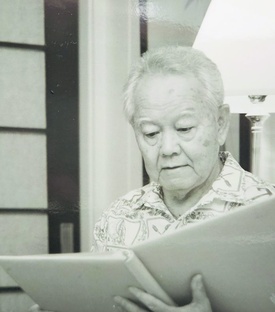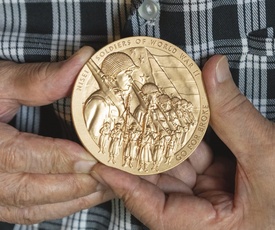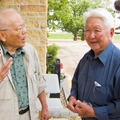With their service as linguists no longer classified, the MIS veterans’ stories about their unusual military experiences began emerging in oral history interviews and in several publications.

As a young man, Hawai‘i-born Ben I. Yamamoto attended several schools in Japan, including prestigious Waseda University. After returning to Hawai‘i and enrolling at the University of Hawai‘i, he was drafted in November 1941, one month before Japan’s attack on Pearl Harbor. While serving with the newly formed 100th Infantry Battalion (Separate), he was recruited because of his high-level Japanese language schooling.
In Japanese Eyes, American Heart: Personal Reflections of Hawaii’s World War II Nisei Soldiers, published by the Hawaii Nikkei History Editorial Board, Yamamoto wrote: “The commanders in the Pacific theater were desperate to learn the enemy’s tactics and strategy. They needed Japanese-language specialists to interpret and translate voice messages and written documents and to interrogate captured prisoners.”
After completing MISLS at Camp Savage, Yamamoto interrogated Japanese prisoners of war at Camp Tracy in California. He served assignments with JICPOA (Joint Intelligence Center, Pacific Ocean Area) in Honolulu, Iwo Jima, Guam and occupied Japan. Of the early days of the occupation, Yamamoto wrote:
When we arrived at Sasebo, about half of our outfit was already there. I was assigned a tedious job: assist in inventorying the torpedoes in various storage locations. There were two Japanese navy officers and a crew of civilians. I was issued a .38 revolver, a holster and 21 rounds of ammunition to protect myself. After all, we did not know how we would be received by the natives.
I packed my six-shooter with me the first two days and was careful not to let any Japanese get behind me. It was an awkward, uncomfortable relationship, with some of the Japanese men casting embarrassing glances at my gun. These people didn’t look dangerous at all; in fact, they looked much like the Issei back home. On the third day, I left my firearms at home. They reacted beautifully. They warmed up to me and worked more enthusiastically. We shared our lunch with each other and played volleyball during our breaks, among other things. I started going to an officer’s apartment for sake and learned to “suck ’em up,” Japanese style. The other officer insisted that I accept his short sword as a memento, a navy issue, since they had lost the war. I still have it.
Some of the neighborhood kids came to our dormitory to visit with us. They looked malnourished and small for their age. We gave them what goodies we had. They tried to return the favors by giving us things.
One little boy gave me a natural pearl he had found on the beach. Another boy told me his mother wanted to do my laundry. Thinking that she offered to do this to earn some money, I let the kid take my soiled clothing home. The boy returned two days later with my laundry neatly folded. I tried to pay him, but he refused payment. This continued during my month-long stay in Sasebo. Later, when woolens were issued to us, I gave all of them to the boy to keep. He later showed me the mittens his mother had made from them.
When it became apparent that my departure was near, I gathered a carton of foodstuffs from my kitchen and made a farewell call on the boy’s family. His mother, a young widow, served me sake and sashimi, which I knew she could ill-afford. I forced them to accept most of the cash I had with me.
I relate these stories to describe the friendly relations that flourished spontaneously with the Japanese. I’m glad I was able to come to Japan at this early period of the occupation, before ending my military service. As Americans, we were there not as arrogant conquerors but with hands extended in friendship and humanity.
According to Seiki Oshiro’s data, Yamamoto ended his military career as a noncommissioned intelligence officer. He died in 2006 and is interred at the National Memorial Cemetery of the Pacific, where his gravesite marker indicates only his service with the 100th Infantry Battalion.

Michael Miyatake also shared his story in Japanese Eyes, American Heart.
The monsoon season had already begun. I was crazy to leave the comforts of camp life to live in the dark jungles of New Guinea. It was suicidal, especially because I had to go to the front, where I would be in constant contact with the enemy.
I was ready to leave in no time. All I carried with me were my duffel bag and field pack filled with tools I would need at the front. It was pouring heavily when I left corps headquarters. Only the driver knew our destination.
Within minutes we were surrounded by darkness.
Fortunately, the enemy had been pushed inland and we were driving through an area secured by friendly forces. Two hours later, we came to a clearing. I was welcomed by a group of Nisei from the 32nd Division Headquarters Language Team headed by Sgt. Mas Yamamoto. It was too early to go to bed, so I went to the language team’s tent to listen to their stories and advice.
I was told not to answer when my name was called by someone whose voice was not familiar — for the caller could be an enemy. They also warned me to be very careful because I could be mistaken as the enemy disguised in an American uniform. Although I would be protected by scouts while enroute to the 112th Regimental Combat Team, the men would certainly consider me the enemy if they couldn’t identify me by looks — for even among our troops there were men who had never met a Nisei.
I was also told that the enemy didn’t know that Nisei were gathering intelligence for Allied forces at the front. It was supposed to have been a secret.
After breakfast, I was introduced to four scouts who were to escort me to the 112th, which was always in contact with the enemy. All intelligence matters, including information on POWs, were being forwarded by them.
Even with the escorts, the thought that the men along the line had not seen me and may not be familiar with what a Nisei looked like made me nervous.
What if one of them thought I was an enemy POW and shot at me? I wasn’t taking any chances; I stuck close to the guards.
My instructions from the 32nd Division Headquarters seemed simple enough to follow, although I later wondered whether they really were. My movements would be slowed by the mud tracks left by the tanks and heavy equipment. I knew I was in trouble from the moment I began plodding into the knee-deep mud. With each step, my feet sank deeper. Progress was slow. I kept thinking I was crazy to have volunteered for this mission.
We finally came to a clearing. Suddenly I heard machine-gun, rifle and mortar fire and grenades exploding. People were yelling. The enemy was staging a banzai attack.
I scrambled for cover in a hole half-filled with water and jumped in without worrying about getting wet. All around me I could see the guards taking cover. As soon as the all-clear sounded, the guards came over to help. I was alright, but my heart was pounding and my legs had locked stiff. I remained in the muddy water for a few minutes before getting out with the guards’ help.
As we walked out of the area where the fighting had taken place, we had to step over hundreds of dead enemy bodies. Some were still grasping hand grenades, the pin already pulled. The slightest movement of a body could have set off an explosion at any moment.
The sight of blood-strewn bodies everywhere made me nauseated. I felt pity, then anger and finally disgust to see so many young lives wasted. This was the first time I had witnessed the aftermath of combat. Walking through the area made me more determined than ever to get out of this mess alive and to let people know how pitiful and merciless the front could be. Relieved of the tension that gripped my entire body, I walked more freely toward the path that led deeper into the jungle.
We finally arrived at the command post of the 112th Regimental Combat Team, where we were met by the commanding officer, Brigadier General Cunningham, and his staff of three officers and an enlisted man.
Serving my country on the front lines as an American soldier whose job was to provide language assistance made me feel important. It made me forget the racial discrimination I had experienced. I vowed that I would serve my country bravely and dutifully. I was determined to protect my comrades and do whatever I could to save their lives, even if it meant sacrificing my own, for we were all fighting for a worthwhile cause.
What I had learned in school about democracy, country, duty and honor did not seem as significant as being out there at the front, facing death. I realized that I had taken my citizenship for granted. I wanted to prove that I was as loyal an American as any other, but also that I was willing to go the extra mile by fighting an enemy, who, like me, was of Japanese ancestry.
Seiki Oshiro’s Excel file, “Entire Army Global Areas MISLA Registry 7362,” notes that Michael Miyatake graduated from the MISLS at Camp Savage in 1943 and was subsequently deployed to the Southwest Pacific Area as a language officer in New Guinea. He then served brief assignments in Iwo Jima and Guam. Miyatake was honorably discharged after completing a postwar assignment in mainland Japan. He was recalled to active duty to serve with the U.S. Civil Administration of the Ryukyus, followed by service during the Korean War. Miyatake was discharged a second time in 1953.
He passed away in 2006 in Honolulu. Although Miyatake originally volunteered for the 442nd Regimental Combat Team and subsequently served in the MIS, his gravesite marker is engraved only with “KOREA,” leaving his MIS service unknown to the ages.

Though the MIS soldiers and their wartime service were cloaked in secrecy throughout the war and into the mid-1970s, once declassified, however, the government did not attempt to update the information in the MISLS Album by providing the graduates’ full names. The dedication and perseverance of The Registry Team of Oshiro, Tani, Ichikawa and their collaborators produced a valuable document of individual records — men and women whose courageous service saved countless lives, helped to shorten the war with Japan and compassionately fostered goodwill and friendship in a country whose people were overcome with defeat.
Thanks to The MISLS Registry, the record is set straight about America’s “secret weapon.”
Asked about future plans for The Registry, Oshiro replied, “There are no future plans at the moment for the maintenance of The Registry.” His daughter, Jo Oshiro of Beaverton, Oregon, said she and her siblings hope to find an organization interested in maintaining it. Ideally, it would have staffing or volunteers to maintain The Registry as new information comes to light, she added.
*This article was originally published in The Hawai‘i Herald on July 21, 2023.
© 2023 Drusilla Tanaka



